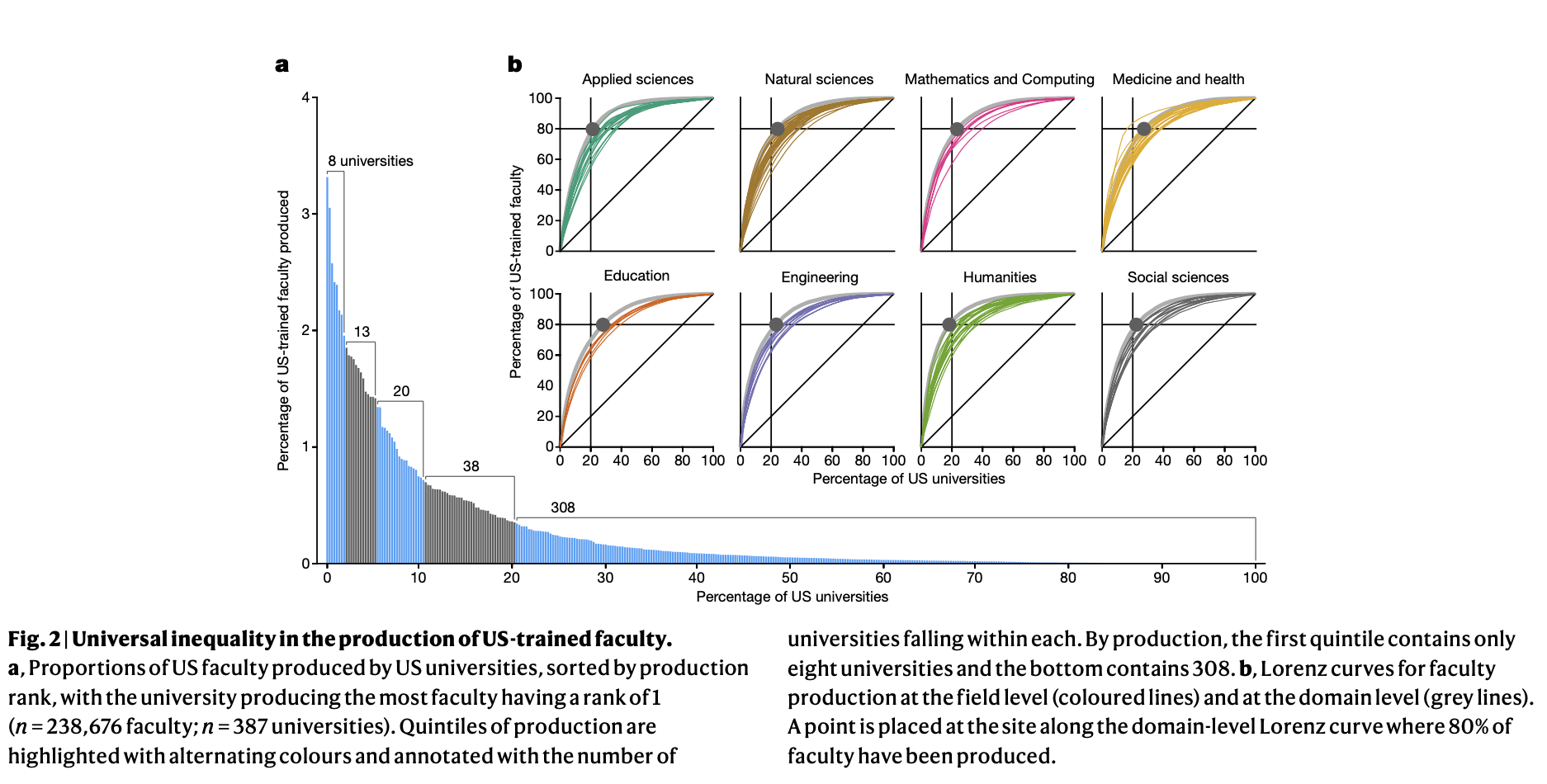You have /5 articles left.
Sign up for a free account or log in.

Network analysis of faculty jobs across academe suggests insular hiring practices.
Jongho Shin/iStock/Getty Images Plus
Some 80 percent faculty members with Ph.D.s in the U.S. trained at just 20 percent of universities. So found the team behind a new study on faculty hiring and retention patterns at Ph.D.-granting institutions. These researchers warn that academe “is characterized by universally extreme inequality in faculty production.”
Researchers also found that the five most common doctoral training universities—the Universities of Michigan; Wisconsin at Madison; and California, Berkeley; plus Harvard and Stanford Universities—account for one in eight U.S.-trained faculty members.
Differences in university or department size did not explain inequalities in faculty production. Findings were relatively consistent across fields.
Where professors got their Ph.D.s also correlated with faculty attrition: over all, researchers observed substantially higher rates of attrition among faculty members trained at those universities that already produce fewer faculty in the first place.
Closed Networks
Previous studies have looked at what’s been called prestige or insular hiring in certain disciplines. One 2015 study on tenured and tenure-track hiring in history, business and computer science Ph.D.-granting programs found that just 25 percent of institutions produced 71 to 86 percent of tenure-line professors. A 2012 study of political science programs found that Ph.D.s from Harvard, Princeton and Stanford Universities, plus Michigan, made up 20 percent of tenure-stream faculty members across more than 100 institutions; the study also found that the top 11 programs were responsible for half the faculty doctorates in the sample.
This new study, published in Nature, adds to the literature by telling a bigger story, analyzing hiring patterns across 107 fields from the humanities to the natural sciences. The data set used, which belongs to an academic research unit within the firm Academic Analytics, included employment records for all tenured or tenure-track faculty members at nearly 400 Ph.D.-granting institutions in the U.S. between 2011 and 2020.
In addition to overrepresentation of faculty Ph.D.s from a sliver of institutions, the new study found what its authors call “ubiquitous hierarchies of prestige.” Via a network analysis, researchers determined that just 5 to 23 percent of faculty members were employed at universities more prestigious than their own doctoral university (as inferred from patterns in faculty hiring), depending on field. Measured by how they restricted “upward mobility” to more prestigious departments, prestige hierarchies were most steep in the humanities (with 12 percent upward mobility) and mathematics and computing (13 percent). They were least steep in medicine and health (21 percent).
Among departments studied that were ranked in the top 10 in any field, 23 percent of top-10 slots were occupied by departments at just five universities: Berkeley, Harvard, Stanford, Madison and Columbia University. More than 250 universities had zero top-10 departments.
“These findings show that, both within individual fields and across entire domains, faculty placement power is highly concentrated among a small set of universities, complementing the already enormous concentration of faculty production among the same set of universities,” the study says. “Together, these patterns create network structures characterized by a closely connected core of high-prestige universities that exchange faculty with each other and export faculty to—but rarely import them from—universities in the network periphery.”

Prestige Hierarchies
“Quantifying Hierarchy and Dynamics in U.S. Faculty Hiring and Retention” was co-authored by K. Hunter Wapman, a graduate student in computer science at the University of Colorado at Boulder. In a series of tweets about the paper this week, Wapman said, “For U.S. profs with U.S. doctorates, we see universal and extreme inequality in faculty production.” Some “20% of profs come from just EIGHT universities,” he added. And as for Berkeley, Harvard, Michigan, Madison and Stanford, “Together, they’ve minted the doctorates of over one in eight sitting US faculty [13.8%]. That’s more than all non-US institutions combined [11%].”
The typical professor was employed at a university that is 18 percent farther down the prestige hierarchy than their doctoral institution, Wapman and his colleagues also found. This and other factors suggest that the typical U.S.-trained professor could expect to supervise 2.4-fold fewer future faculty members than their doctoral adviser did, the study says.
Looking at the specific phenomenon of “self-hiring,” or when Ph.D. students end up as professors where they trained, researchers found this accounts for 9 percent of all U.S. professors in the sample and 11 percent of U.S.-trained professors specifically. This rate remains low compared to those for other countries, but it is consistently greater than would be randomly expected.
Interestingly, researchers found that self-hires were at greater risk of attrition than non-self-hires, especially in criminal justice and criminology and industrial engineering, at 1.9- and 1.8-fold the attrition rate of other faculty members, respectively.
Effects on Knowledge Production
In addition to hiring patterns, other recent studies hint at the way the professoriate replicates itself. One paper in Nature: Human Behavior (which shares two co-authors with the new study on hiring) found that 22 percent of tenure-track faculty members have a parent with a Ph.D.
“Our results suggest that the professoriate is, and has remained, accessible disproportionately to the socioeconomically privileged, which is likely to deeply shape their scholarship and their reproduction,” that paper said.
Other research suggests that economics Ph.D.s, in particular, are increasingly likely to have at least one parent with a graduate degree.
Aaron Clauset, professor of computer science at Boulder and a co-author of both the hiring prestige and parents-with-Ph.D.s papers, said Thursday, “There is certainly a connection between the two results [on prestige hiring and parents with Ph.D.s], and it seems highly likely that both patterns influence academic scholarship in deep ways. The magnitude of the overrepresentation of very narrow ranges of individuals is jarring, and I think a real benefit of both studies is to quantify these patterns in great detail, pointing to specific places where more causal study is needed.”
As a field, however, he said, “we are only just beginning to understand how much and in what ways these disparities in who ends up as tenure-track faculty at Ph.D.-granting universities in the U.S. [shape] what scholarship is produced and what discoveries are made.”
One key reminder: most prestige-hiring studies, including the new one, only consider Ph.D.-granting institutions. Hiring patterns may look very different when considering associate, baccalaureate and master’s degree–granting institutions, as well. Another note: these studies typically exclude faculty members working off the tenure track.
Political scientist Shannon Jenkins, associate dean of arts and sciences at the University of Massachusetts at Dartmouth, who earned her Ph.D. at Loyola University in Chicago, said she found the findings on closed hiring networks “troubling.” At the same time, she said, at her own institution (which grants Ph.D.s in some programs), the faculty is “very diverse in terms of the institutions where they got their terminal degree. We have some faculty from elite Ph.D.-granting institutions, but most of our faculty come from institutions that are very different than that. We have an exceptional faculty that we are very proud of, and they come from a lot of places.”





